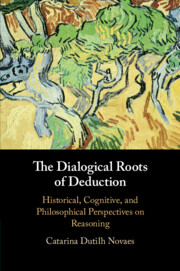Refine search
Actions for selected content:
5913 results in Programming Languages and Applied Logic
Part II - The History of Deduction
-
- Book:
- The Dialogical Roots of Deduction
- Published online:
- 10 December 2020
- Print publication:
- 17 December 2020, pp 85-148
-
- Chapter
- Export citation
Part III - Deduction and Cognition
-
- Book:
- The Dialogical Roots of Deduction
- Published online:
- 10 December 2020
- Print publication:
- 17 December 2020, pp 149-237
-
- Chapter
- Export citation
7 - Logic and Deduction in the Middle Ages and the Modern Period
- from Part II - The History of Deduction
-
- Book:
- The Dialogical Roots of Deduction
- Published online:
- 10 December 2020
- Print publication:
- 17 December 2020, pp 131-148
-
- Chapter
- Export citation
9 - The Ontogeny of Deductive Reasoning
- from Part III - Deduction and Cognition
-
- Book:
- The Dialogical Roots of Deduction
- Published online:
- 10 December 2020
- Print publication:
- 17 December 2020, pp 169-186
-
- Chapter
- Export citation
2 - Back to the Roots of Deduction
- from Part I - The Philosophy of Deduction
-
- Book:
- The Dialogical Roots of Deduction
- Published online:
- 10 December 2020
- Print publication:
- 17 December 2020, pp 22-36
-
- Chapter
- Export citation
Part I - The Philosophy of Deduction
-
- Book:
- The Dialogical Roots of Deduction
- Published online:
- 10 December 2020
- Print publication:
- 17 December 2020, pp 1-84
-
- Chapter
- Export citation
8 - How We Reason, Individually and in Groups
- from Part III - Deduction and Cognition
-
- Book:
- The Dialogical Roots of Deduction
- Published online:
- 10 December 2020
- Print publication:
- 17 December 2020, pp 151-168
-
- Chapter
- Export citation
Contents
-
- Book:
- The Dialogical Roots of Deduction
- Published online:
- 10 December 2020
- Print publication:
- 17 December 2020, pp v-vii
-
- Chapter
- Export citation
Copyright page
-
- Book:
- The Dialogical Roots of Deduction
- Published online:
- 10 December 2020
- Print publication:
- 17 December 2020, pp iv-iv
-
- Chapter
- Export citation
4 - Deduction as a Dialogical Notion
- from Part I - The Philosophy of Deduction
-
- Book:
- The Dialogical Roots of Deduction
- Published online:
- 10 December 2020
- Print publication:
- 17 December 2020, pp 61-84
-
- Chapter
- Export citation
Preface
-
- Book:
- The Dialogical Roots of Deduction
- Published online:
- 10 December 2020
- Print publication:
- 17 December 2020, pp ix-xiv
-
- Chapter
- Export citation
References
-
- Book:
- The Dialogical Roots of Deduction
- Published online:
- 10 December 2020
- Print publication:
- 17 December 2020, pp 238-260
-
- Chapter
- Export citation

The Dialogical Roots of Deduction
- Historical, Cognitive, and Philosophical Perspectives on Reasoning
-
- Published online:
- 10 December 2020
- Print publication:
- 17 December 2020
2 - Probabilistic Programs as Measures
-
-
- Book:
- Foundations of Probabilistic Programming
- Published online:
- 18 November 2020
- Print publication:
- 03 December 2020, pp 43-74
-
- Chapter
-
- You have access
- Open access
- Export citation
List of Contributors
-
- Book:
- Foundations of Probabilistic Programming
- Published online:
- 18 November 2020
- Print publication:
- 03 December 2020, pp vii-x
-
- Chapter
-
- You have access
- Open access
- Export citation
1 - Semantics of Probabilistic Programming: A Gentle Introduction
-
-
- Book:
- Foundations of Probabilistic Programming
- Published online:
- 18 November 2020
- Print publication:
- 03 December 2020, pp 1-42
-
- Chapter
-
- You have access
- Open access
- Export citation
Preface
-
- Book:
- Foundations of Probabilistic Programming
- Published online:
- 18 November 2020
- Print publication:
- 03 December 2020, pp xi-xiv
-
- Chapter
-
- You have access
- Open access
- Export citation
15 - Programming Unreliable Hardware
-
-
- Book:
- Foundations of Probabilistic Programming
- Published online:
- 18 November 2020
- Print publication:
- 03 December 2020, pp 533-568
-
- Chapter
-
- You have access
- Open access
- Export citation
4 - On Probabilistic λ-Calculi
-
-
- Book:
- Foundations of Probabilistic Programming
- Published online:
- 18 November 2020
- Print publication:
- 03 December 2020, pp 121-144
-
- Chapter
-
- You have access
- Open access
- Export citation
8 - Quantitative Analysis of Programs with Probabilities and Concentration of Measure Inequalities
-
-
- Book:
- Foundations of Probabilistic Programming
- Published online:
- 18 November 2020
- Print publication:
- 03 December 2020, pp 259-294
-
- Chapter
-
- You have access
- Open access
- Export citation
